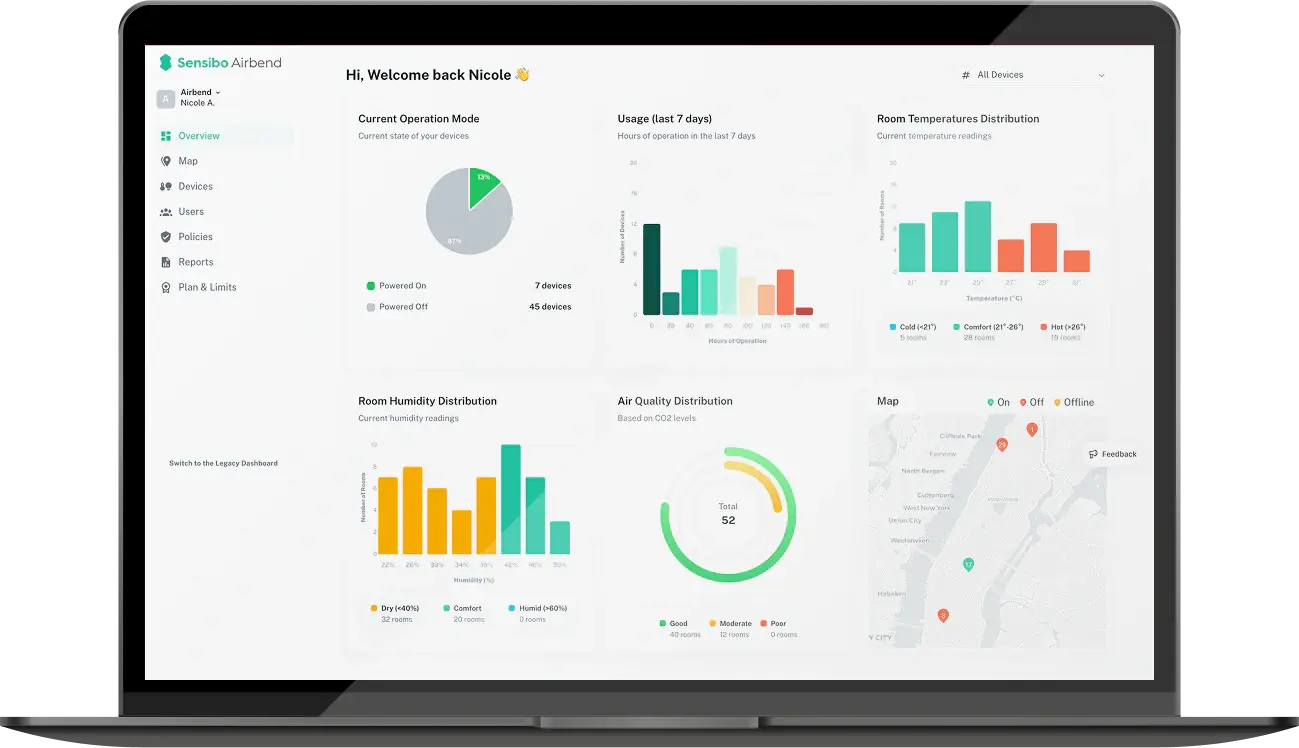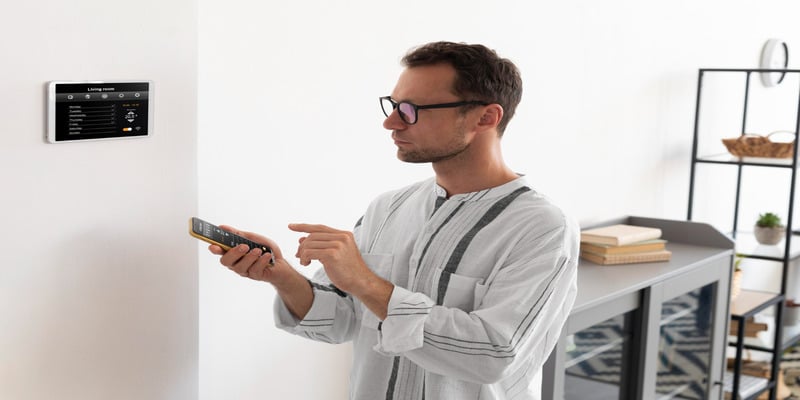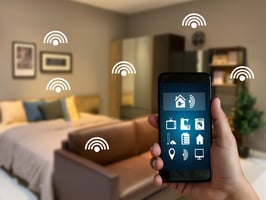Understanding the Key Benefits of Smart Thermostats for Homeowners
Your thermostat probably looks like it belongs in 1995. Meanwhile, you're paying massive heating and cooling bills while manually adjusting temperatures every time you leave the house or come home to a freezing cold living room. The benefits of smart thermostats lie in fixing these problems, but figuring out if they're worth the money requires understanding what they actually do versus the marketing hype.
What Makes These Thermostats Different
Smart thermostats work as a device that automatically regulates temperature while connecting to your Wi-Fi. Regular programmable thermostats follow rigid schedules you set once and forget. Smart versions adapt to your actual life.
They track when you're usually home or away. They check weather forecasts. They make tiny adjustments throughout the day that add up to real savings. Your heating and cooling systems run more efficiently without you thinking about temperature control.
Most include touchscreens, phone apps, and voice control. They detect when someone's home, get software updates, and show detailed reports about your home's energy usage.
The difference feels dramatic once you experience automatic temperature management that actually works.
What Smart Thermostats Actually Cost and Save
Studies tracking thousands of homes show smart thermostats save 12% on heating bills and 15% on cooling costs. For typical households spending $900+ yearly on heating and cooling, that's $108-135 back in your pocket annually.
Energy Star-certified models average 8% savings on total heating and cooling bills - roughly $50 yearly for most homes. These numbers come from comparing actual utility bills before and after installation, not laboratory estimates.
Here's why those savings happen: 40-70% of people with programmable thermostats never use the scheduling features because they're too complicated. Smart thermostats make adjusting the temperature so easy through phone apps that people actually use the energy-saving features.
The benefits of smart thermostat technology show up within months, not years.
 Remote Control: Managing Your Home from Anywhere
Remote Control: Managing Your Home from Anywhere
The most useful thermostat feature eliminates coming home to uncomfortable temperatures. Cool your house during your drive home. Warm it up before you get out of bed. Adjust settings from vacation when you realize you forgot to change them before leaving.
Smart thermostats send alerts if your home gets unusually hot or cold, protecting against frozen pipes or equipment damage. Some detect HVAC problems and notify you before expensive repairs become necessary.
You get maintenance reminders through your phone instead of trying to remember when you last changed the filter or scheduled service.
How Your Thermostat Gets Smarter
Smart thermostat benefits include automatic schedule creation based on your real behavior. Instead of programming complex schedules, these devices watch when you're home and adjust accordingly.
Better models detect motion and occupancy in real time, heating or cooling only when needed. Geofencing technology senses when you're driving home and starts temperature adjustments before you arrive.
The learning continues year-round, adapting to seasonal routine changes and local weather patterns. You get better comfort and efficiency without constantly tweaking settings.
This automation actually works because the devices use multiple data sources - your schedule, local weather, your preferences, and occupancy detection.
How Smart Features Create Energy Savings
Smart thermostats save money through automated strategies that regular thermostats can't handle. They make gradual temperature changes instead of dramatic swings, reducing strain on your HVAC system.
Weather integration factors outdoor conditions into heating and cooling decisions. On mild days, they extend time between heating cycles or take advantage of natural temperature shifts.
"Eco mode" settings prioritize efficiency over perfect comfort, making small adjustments most people won't notice but that add up to significant savings.
The benefits of installing a smart thermostat become obvious when you see detailed energy usage reports showing exactly when and how much you're saving.
Advantages of Smart Thermostat Integration with Other Devices
Smart thermostats connect with voice assistants like Alexa, Google Assistant, and Siri. Change temperatures, check settings, or ask about energy use without touching any controls.
Integration with other smart devices creates useful automation. Your thermostat can work with smart blinds to block heat during summer afternoons or coordinate with smart lighting to optimize total energy consumption.
Some connect with utility demand response programs, automatically adjusting temperatures during peak usage periods in exchange for rebates or lower electricity rates.
Installation and Compatibility Reality
Most smart thermostats work with standard heating and cooling systems, but compatibility varies. Heat pumps, multi-stage systems, and older equipment may need specific models or additional wiring.
The "C-wire" requirement provides continuous power to smart features. Homes built in the last 20 years usually have this wire. Older homes might need professional installation to add one.
DIY installation works for many homeowners, but professional installation costs $50-150 and ensures everything works properly. Many utility companies offer rebates covering installation costs.
 Pros and Cons of Smart Thermostat Ownership
Pros and Cons of Smart Thermostat Ownership
What works well:
- Significant energy cost reductions
- Convenient remote access and control
- Automatic maintenance reminders
- Integration with smart home systems
- Detailed energy usage insights
Potential problems:
- Higher upfront costs ($100-300 vs $25-50 for basic models)
- Compatibility issues with older HVAC systems
- Learning curve for using all features
- Privacy concerns with data collection
- Dependence on reliable Wi-Fi
Advantages of Smart Thermostat Technology for Different Homes
Small apartments: Basic smart models provide remote control and scheduling without complex features you won't use.
Large homes: Multi-zone systems with room sensors ensure balanced comfort throughout different areas.
Vacation properties: Remote monitoring prevents temperature-related damage and lets you prepare spaces before arrival.
Rental properties: Smart thermostats attract tech-savvy tenants while giving landlords usage insights and remote troubleshooting capabilities.
Environmental Impact
Smart thermostats reduce overall energy consumption. If installed in every home with HVAC systems, these devices could cut national space heating and cooling energy use by 9%.
This reduction means lower carbon emissions from power plants and decreased strain on electrical grids during peak demand periods. Many utility companies promote smart thermostat adoption through rebate programs, recognizing these benefits.
The devices also extend HVAC system lifespan by optimizing operation patterns and reducing unnecessary runtime, decreasing replacement frequency.
Benefits of Smart Thermostat: When Upgrading Makes Sense
Smart thermostats work best for households that:
- Spend $600+ annually on heating and cooling
- Have irregular schedules or travel frequently
- Want detailed insight into energy consumption
- Plan to add other smart home devices
- Value convenience and remote control
The investment typically pays for itself within 2-3 years through energy savings alone, with continued benefits throughout the device's 10+ year lifespan.
For homes with consistent schedules and people comfortable with manual adjustments, a basic programmable thermostat might provide sufficient benefits at a lower cost.
Making the Smart Choice
Smart thermostats represent one of the most cost-effective home upgrades available. The technology has improved beyond early adoption problems, offering reliable performance for most homeowners. Lower energy bills, better comfort control, and environmental benefits justify the cost for most situations. Evaluate your current heating and cooling expenses, then choose a model matching your technical comfort level and feature preferences.
FAQ
How much will I actually save with a smart thermostat?
Real-world studies show 12-15% savings on heating and cooling costs, typically $50-135 annually for most households. Actual savings depend on your current habits, local climate, and system efficiency.
Will a smart thermostat work with my HVAC system?
Most work with standard systems, but heat pumps, multi-stage equipment, and older installations may need specific models. Check compatibility before buying or consult an HVAC professional.
Do I need professional installation?
Many homeowners can install them, but professional installation ensures compatibility and proper setup. Costs $50-150 and may require maintaining HVAC warranties.
How long does it take to learn my schedule?
Most learning models need 1-2 weeks for basic patterns and continue refining over several months. You can manually program schedules while the device learns.
Are there security risks?
Like all connected devices, smart thermostats have potential privacy and security concerns. Choose models from reputable manufacturers that provide regular security updates.
Can a smart thermostat work without Wi-Fi?
Basic functions like temperature control and programmed schedules work without internet, but remote access, learning features, and smart integrations require stable Wi-Fi.
What rebates are available?
Many utility companies offer $25-100 rebates for Energy Star-certified models. Check with your local utility provider and look for federal or state energy efficiency incentives.
How do smart thermostats help with maintenance?
Most track filter life, system runtime, and performance metrics, sending reminders for routine maintenance. Some detect potential issues and alert you before major problems develop.





































.jpg?height=200&name=photo_2024-11-08_11-56-41%20(1).jpg)
